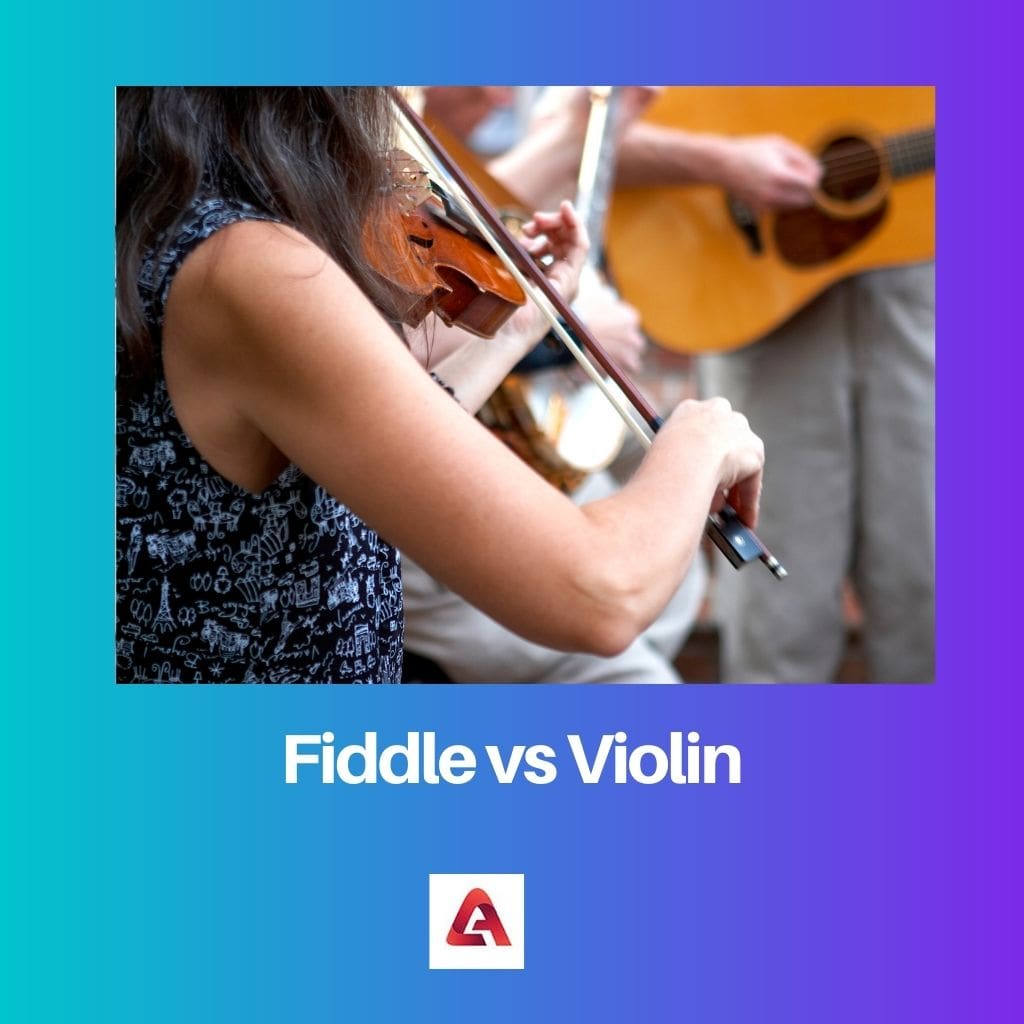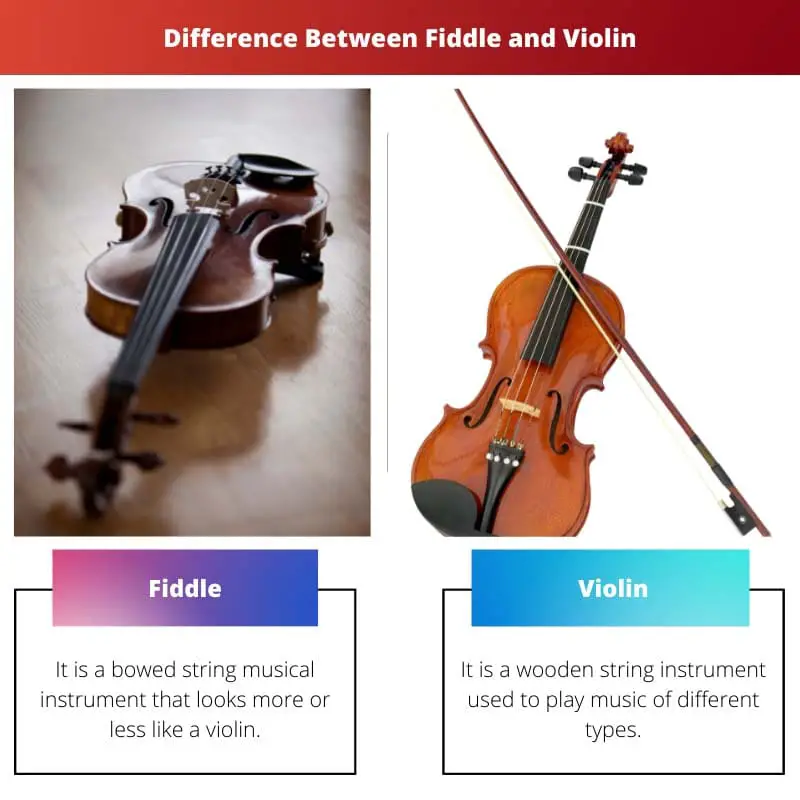The distinction between a fiddle and a violin lies primarily in their respective styles and traditions. While both instruments are essentially the same in structure and design, the term “fiddle” denotes a folk or traditional context, emphasizing improvisation and rhythmic elements, whereas “violin” refers to its classical usage, focusing on precise technique and interpretation.
Key Takeaways
- Fiddle is a colloquial term for a violin used in folk, country, or traditional music, while violin refers to the classical instrument used in orchestras and chamber music.
- Fiddle playing involves more improvisation and rhythmic variation than violin playing, which is more structured and formal.
- Fiddle and violin are identical, but their usage and cultural connotations differ.
Fiddle vs Violin
Fiddlers use different techniques and ornamentation than classical violinists, and may use different types of bows or strings. The term “violin” is more commonly used in classical music, and is associated with a more formal playing style. Classical violinists follow a strict set of techniques and traditions.

Comparison Table
| Feature | Fiddle | Violin |
|---|---|---|
| Physical Appearance | Identical | Identical |
| Playing Style | More improvisational, energetic | More formal, precise |
| Music Genres | Folk, bluegrass, country, Cajun | Classical, orchestral, chamber music |
| Strings | Often steel strings for brighter sound | Often gut or synthetic core strings for warmer sound |
| Bridge | May have a flatter bridge for easier playing | Typically has a higher, more curved bridge |
| Tuning | Standard violin tuning (G, D, A, E) | Standard violin tuning (G, D, A, E) |
| Notation | Often played by ear | Played from sheet music |
What is Fiddle?
A fiddle is a stringed musical instrument, with four strings, played with a bow. It shares the same basic structure as a violin, consisting of a body, neck, strings, and bow, but it is associated with folk, country, bluegrass, and other traditional styles of music.
Origins and Evolution
The term “fiddle” has its roots in medieval Europe, where it was used interchangeably with “violin.” Over time, however, the term became more associated with informal, folk, and dance music, particularly in regions such as Ireland, Scotland, Appalachia, and parts of North America.
Characteristics and Playing Style
Fiddles are played with a more relaxed technique compared to classical violin playing. They are commonly used in styles where improvisation, ornamentation, and rhythmic elements play a significant role. Fiddle players employ techniques such as double stops, drones, and slides to create distinctive sounds and textures.
Cultural Significance
The fiddle holds significant cultural importance in many societies, serving as a centerpiece of traditional music and dance. It has been passed down through generations, with regional styles and repertoire reflecting local customs and heritage. The instrument’s versatility and accessibility have made it a beloved part of folk music traditions worldwide, cherished for its ability to evoke emotions, tell stories, and bring communities together.

What is Violin?
The violin is a classical stringed musical instrument with four strings, played with a bow. It is renowned for its versatility, expressive capabilities, and rich history within Western classical music.
Origins and Development
The violin traces its origins back to Renaissance Europe, where it evolved from earlier stringed instruments such as the rebec and the medieval fiddle. Its design underwent refinements over the centuries, leading to the development of the modern violin by renowned luthiers such as Antonio Stradivari and Guarneri del Gesù during the 17th and 18th centuries.
Characteristics and Technique
The violin is characterized by its elegant, hourglass-shaped body, curved neck, and fine craftsmanship. It is played by drawing a bow across the strings or by plucking them with the fingers (pizzicato). Violinists employ a rigorous technique that emphasizes precision, control, and nuanced expression. Classical violin repertoire encompasses a vast range of musical styles, from Baroque to contemporary compositions, demanding both technical virtuosity and interpretative sensitivity.
Cultural Influence and Legacy
The violin holds a revered place in Western classical music, serving as a solo instrument, a vital member of the orchestra, and a cornerstone of chamber ensembles. Its expressive capabilities have made it a favorite of composers throughout history, with iconic works such as Johann Sebastian Bach’s Sonatas and Partitas for Solo Violin, Wolfgang Amadeus Mozart’s Violin Concertos, and Pyotr Ilyich Tchaikovsky’s Violin Concerto showcasing its versatility and emotional range.

Main Differences Between Fiddle and Violin
- Style and Context:
- Fiddles are associated with folk, country, bluegrass, and traditional music, whereas violins are primarily linked with classical music.
- Playing Technique:
- Fiddle players tend to use a more relaxed and rhythmic playing style, emphasizing improvisation, ornamentation, and rhythmic elements.
- Violinists employ a more formal and precise technique, focusing on accuracy, intonation, and interpretation of classical compositions.
- Repertoire and Ornamentation:
- Fiddle music includes improvisation, variations, and embellishments, reflecting regional styles and cultural influences.
- Violin repertoire is predominantly composed and notated, with emphasis on faithfully interpreting written scores and adhering to established classical traditions.
- Instrument Setup:
- While the basic structure of the instrument remains the same, fiddles may have slight variations in setup, such as flatter bridges or different types of strings, to accommodate specific playing styles.
- Violins adhere to standardized setups and specifications to achieve optimal sound quality and playability in classical music settings.
- Cultural Associations:
- Fiddles are deeply rooted in folk traditions and are associated with community gatherings, dances, and informal performances.
- Violins hold a prestigious place in classical music culture, with associations to concert halls, symphony orchestras, and solo recitals, representing high artistry and musical refinement.

- https://vbn.aau.dk/ws/files/52846595/NIME2011OvertoneFiddlePhotoReady.pdf
- https://elibrary.ru/item.asp?id=7301104

This article effectively differentiates between a fiddle and a violin, shedding light on the distinct cultural and musical contexts in which each instrument is used. The comparison table provides a comprehensive overview of their differences, making it easier for readers to understand their unique characteristics.
I completely agree. The detailed breakdown of the anatomy and characteristics of both instruments is highly informative and enriches the reader’s understanding of their usage in various musical genres.
The article is a valuable resource for musicians and music enthusiasts who want to delve deeper into the differences between fiddles and violins. It offers a well-researched and articulate explanation of their respective roles in different musical traditions.
The article’s in-depth analysis of the fiddle and violin effectively captures their distinct characteristics and cultural connotations. It’s an enlightening read for music enthusiasts seeking a comprehensive understanding of these instruments.
I couldn’t agree more. The article offers a thorough examination of the fiddle and violin, presenting a nuanced portrayal of their significance in varied musical genres and traditions.
The article effectively highlights the distinctions between fiddle and violin, providing valuable insights into their cultural and musical significance. It’s a great read for anyone interested in understanding the role of these instruments in different musical genres.
This article offers an insightful exploration of the fiddle and violin, elucidating the unique playing styles, construction, and social contexts associated with each instrument. It provides a well-rounded understanding of their roles in diverse musical traditions.
Absolutely! The detailed comparison table makes it easy to grasp the nuanced differences between fiddle and violin, enhancing the reader’s knowledge and appreciation of these instruments.
The article provides a compelling overview of the fiddle and violin, shedding light on their unique characteristics and cultural connotations. It’s an enlightening read for anyone interested in the intricate world of musical instruments.
The article provides an excellent overview of the fiddle and violin, offering detailed insights into their construction, playing styles, and cultural contexts. It’s a fascinating read that deepens one’s appreciation of these instruments.
Absolutely! The comparison between fiddle and violin is presented with clarity and precision, making it an engaging and educational piece for music enthusiasts.
The article offers a compelling analysis of the fiddle and violin, highlighting their distinct roles in different musical genres. It provides a captivating exploration of their historical and cultural significance.
The article effectively distinguishes the fiddle from the violin, providing a comprehensive overview of their usage in different musical genres. It’s a compelling and informative piece that sheds light on their cultural significance.
The article offers a well-researched and articulate exploration of the fiddle and violin, providing a nuanced understanding of their distinctive characteristics and musical contexts. It’s a commendable contribution to music scholarship.
I wholeheartedly agree. The article’s thorough analysis of the fiddle and violin deepens one’s appreciation of their cultural and musical significance, making it an engaging and informative read.
Absolutely! The article’s detailed comparison table enriches our knowledge of the fiddle and violin, offering a comprehensive understanding of their roles in diverse musical traditions.
The article offers a detailed exploration of the fiddle and violin, providing valuable insights into their distinctive roles in folk, country, and classical music. It’s a fascinating read that enhances one’s understanding of these iconic instruments.
Absolutely! The article’s nuanced portrayal of the fiddle and violin deepens our appreciation of their cultural and musical significance, making it a captivating and informative piece.
The article is a well-researched and articulate exploration of the fiddle and violin, shedding light on their unique attributes and cultural relevance. It’s a valuable resource for anyone interested in the rich tapestry of musical instruments.
The article presents a thorough and insightful examination of the fiddle and violin, elucidating their unique characteristics and musical applications. It’s a valuable contribution to the discourse on musical instruments and traditions.
I couldn’t agree more. The article’s in-depth analysis enhances our understanding of the fiddle and violin, underscoring their diverse cultural and musical associations.